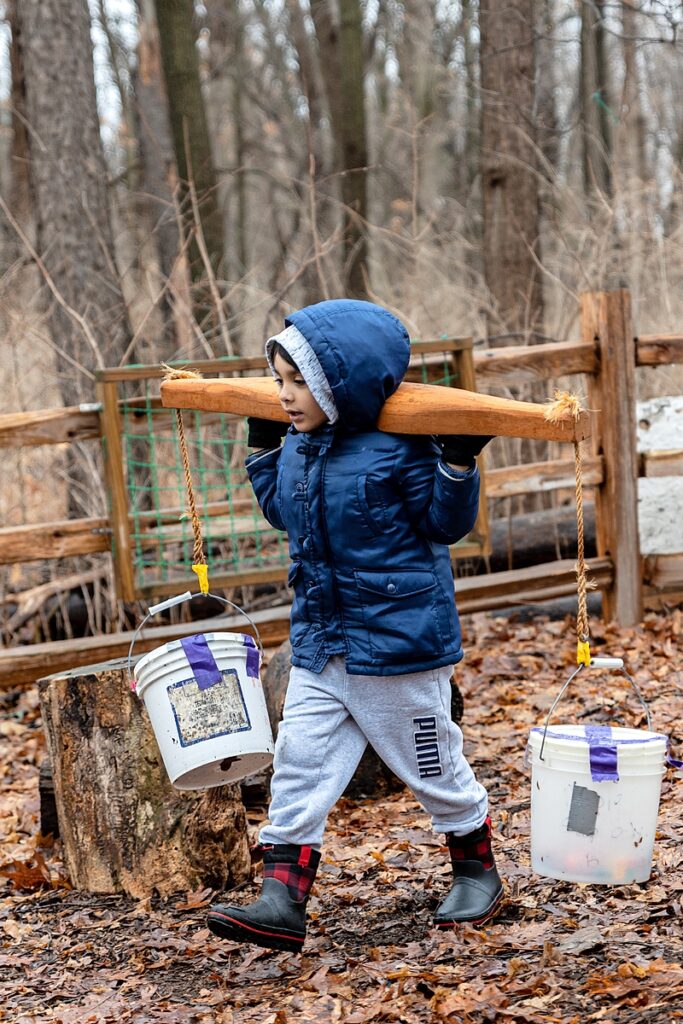Sappy New Year
By Jen Banowetz
Appears in the March 2023 issue.
Maple sugaring season is short but sweet

Drip … drip … drip …
Ahh, that satisfying sound signals the end of winter. Or more specifically, maple sap plinking into a metal bucket. March means maple sugaring season, a traditional harbinger of spring—as well as some pretty cool natural science at work.
Maple syrup is made from just one ingredient: maple sap. And maple sugaring is the process of collecting that sap from tapped sugar maple trees then boiling it down into syrup (or even further into crystalized maple sugar).

“Tapping a tree involves creating a small hole in the bark that goes all the way into the sweet sapwood of the tree,” explains Renée Oakley, facility manager of Red Oak Nature Center in North Aurora. “This hole allows a device called a spile to be inserted that intercepts the sweet sap as it flows up and down between the roots and the branches of the tree. This gathers just a little bit of the sap at a time so as not to hurt the tree. It’s why many trees are used for this process, to make sure that no one tree gives up more of its sap than just that trickle.”
Once the sap leaks out of the spile, it’s slowly collected in a bucket, then boiled—and boiled and boiled. “Evaporation is the most basic science concept behind maple sugaring,” Oakley says. “Boiling away excess water in tree sap is what reveals that sweet syrup.” But it takes a lot of sap (which is about 98 percent water) and a lot of cooking time. “Up to 40 gallons of tree sap is needed to harvest one gallon of syrup.” Yet another reason why so many trees are needed.
The changing season is key, with days getting longer and temps rising above freezing. “Spring is the time of year that this process works because the cold nights and sunny days of spring tell the tree it is time to release sap from its roots—the sugar that is in that stored sap is the strongest concentration of the year,” Oakley says.

While the science is pretty simple, it’s also pretty specific. The sap is harvested when the daytime temperatures reach between 40 and 50 degrees Fahrenheit and nighttime temperatures drop below freezing. It’s this freezing and thawing of sap inside the trees that creates an internal pressure, so the sap will drip out of the inserted spile.
“Why does the tree need sap? Trees use this sap to grow leaves so that they can make more food for themselves via photosynthesis,” Oakley says. “Why maples? Maple trees are known to have some of the sweetest sap around with the highest concentration of sugars.”
Like all good things, the flowing sap must come to an end. When the tree buds begin to open, the upward flow of sap in the sapwood stops. Any sap collected at this point is tainted with other compounds from the leaf buds, giving it a not-so-pleasant taste.
The maple sugaring window may be short, but luckily there are plenty of local spots to experience it firsthand.

Maple Fest
Red Oak Nature Center
930 N. River Rd., North Aurora
When: 9 a.m. to 1 p.m. March 18 and 11 a.m. to 2 p.m. March 19 (tours on the hour)
Admission: $5 advance registration (everyone 3 years and up must have a timed entry.)
Details: This annual event includes an indoor presentation followed by a guided hike and sampling. redoaknaturecenter.info

Maple Sugaring
Kline Creek Farm
1N600 County Farm Rd., West Chicago
When: 1 to 4 p.m. every Saturday and Sunday in March
Admission: Free, no registration required. Suggested donation $5 for those 3 and up.
Details: Learn about the process as it was done in the 1890s, complete with hand tools for tapping and a cauldron over an open fire. If you’d like to try tapping your own maple tree at home, the Timber Ridge Visitor Center sells supplies. dupageforest.org/kline-creek-farm
Maple Sugaring Days
Creek Bend Nature Center at LeRoy Oakes Forest Preserve
37W700 Dean St., St. Charles
When: Noon to 3 p.m. March 4 and March 5
Admission: Free, no registration required.
Details: Learn how to drill and set a tap and watch the sap thicken over an open fire. Treats and locally sourced maple syrup available for purchase (cash only). kaneforest.com
Woodland Family Hikes
The Morton Arboretum
4100 Rte. 53, Lisle
When: 11 a.m. to noon or 1 to 2 p.m. March 4 and 11 a.m. to noon or 1 to 2 p.m. March 11
Admission: $10 for members and $17 for guests, registration required.
Details: The theme of March’s family hikes is a maple-tapping trek in the east woods to learn about the history of maple trees (with tasting too). Recommended for families with children ages 4 and older. mortonarb.org
Sap to Syrup Celebration
Hoover Forest Preserve
11285 W. Fox Rd., Yorkville
When: 10 to 11 a.m. March 11
Admission: $6/person to register (3 and under are free.)
Details: Take a guided outdoor tour with stations, ending with syrup tasting. Includes a make-and-take craft for kids. kendallforest.com
Photos courtesy of the Fox Valley Park District (Red Oak Nature Center) and Jen Banowetz (Kline Creek Farm)


